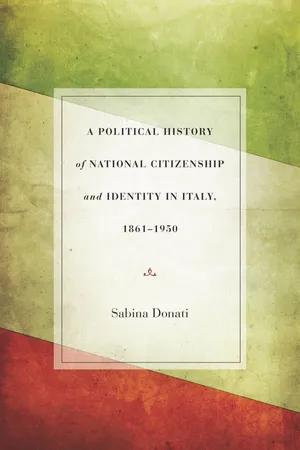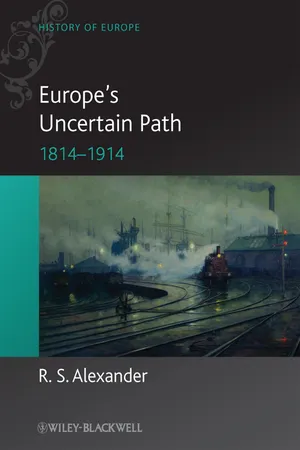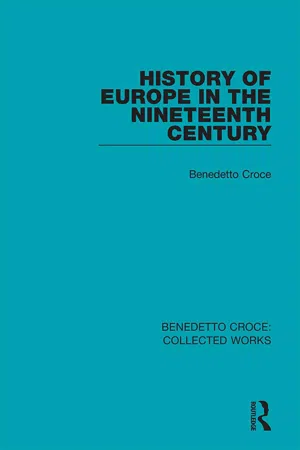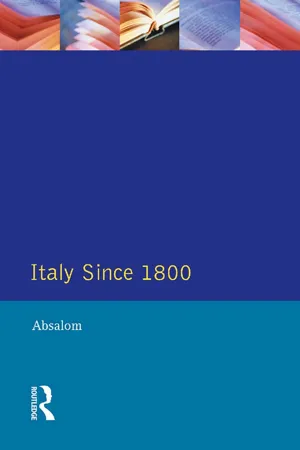History
Unification of Italy
The Unification of Italy refers to the 19th-century process by which the Italian states unified to form the Kingdom of Italy. Led by figures like Giuseppe Garibaldi and Count Camillo di Cavour, this movement aimed to create a single, unified Italian nation-state. The process involved diplomatic maneuvering, military campaigns, and the overthrow of foreign rule in various Italian regions.
Written by Perlego with AI-assistance
Related key terms
Related key terms
1 of 4
Related key terms
1 of 3
8 Key excerpts on "Unification of Italy"
- Sabina Donati(Author)
- 2013(Publication Date)
- Stanford University Press(Publisher)
The historical developments leading to a unified Italy under the Savoy King Vittorio Emanuele II shaped and determined not only the Italian process of attaining independent statehood but also the origins of the national citizenship link that came to unite the “divided” peoples of the peninsula. In particular, the period from 1859 to 1866 establishes the historical roots of the post-unification juridical membership status that will subsequently develop throughout the liberal and the fascist epochs. The purpose of this first chapter is therefore to focus on this eight-year period of pre- and post-unification Italian history with a view to discussing the genesis and the first characteristics of the national civic bond uniting the Italians of the 1861 state within a peculiar context of internal divisions—linguistic, economic, social and mental—that were also enriched with specific racial considerations. In this way, the still relatively unknown and distant origins of today’s Italian citizenship will finally emerge fully from the dust of archives and of public libraries.1.1. THE SAVOY ROAD TO POLITICAL UNIFICATION AND THE BIRTH OF ITALIAN MONARCHICAL SUBJECTHOOD (1859–1861)The nineteenth-century period of Italian Risorgimento saw the burgeoning of a variety of nationalist political programs that aimed in different ways and through different means to accomplish the political unification of the Italian peninsula. These diverse nationalist projects ranged, among others, from radical revolutionary republicanism—as personified by Giuseppe Mazzini—to liberal Catholic patriotism—as represented by Vincenzo Gioberti—to moderate liberal monarchism—as symbolized by Camillo Benso di Cavour.“Patriot and democrat, prophet and politician,”2 the Genoese Mazzini (1805–1872) strove for an Italy that in his view had to become a unitary and democratic republic, free from foreign occupation and enjoying statehood within the highest objective of contributing, with all other nation-states, to the development of humanity. This optimistic and idealist program was a radical one and had to be carried out through both education and popular insurrection.3 The Piedmontese cleric Vincenzo Gioberti (1801–1852), by contrast, a liberal-catholic, supporting neo-Guelphian principles and seeking to reconcile a commitment to Italian independence with loyalty to Catholicism, called for establishment of an Italian confederation of existing rulers and states under the guidance and the leadership of the pontiff.4- eBook - ePub
- James Robinson, Charles Beard(Authors)
- 2017(Publication Date)
- Jovian Press(Publisher)
THE Unification of Italy
~ CAVOUR AND ITALIAN UNITYThe efforts of the Italian liberals to expel Austria from the peninsula and establish constitutional governments in the various Italian states had failed, and after the battle of Novara it seemed as if the former political conditions were to be restored. The king of Naples broke all the promises which he had made to his subjects, revoked the constitution which he had granted, and imprisoned, exiled, or in some cases executed the revolutionists. The Pope, with the assistance of France, Austria, Naples, and Spain, was able to destroy the Roman Republic which had been set up, and place the government again in the hands of the ecclesiastics. In northern Italy Austria was once more in control, and she found faithful adherents in the rulers of Modena, Parma, and Tuscany, who looked to her for continued support. The leading spirits of the revolution who had escaped prison or death fled to foreign countries to await a more auspicious opportunity to secure their ends, for they did not surrender the hope that Austria would sometime be driven from their country, and all the Italian states brought together into a federation, or perhaps united into a single monarchy or republic.However, those who, since the fall of Napoleon I, had been interested in promoting Italian independence and liberty differed from one another as to the best way in which to make Italy a nation. There were the republicans, who became more and more disgusted with monarchy and believed that nothing could be accomplished until the various rulers should give way to a great democratic republic, which should recall the ancient glories of Rome; others were confident that an enlightened Pope could form an Italian federation, of which he should be the head; lastly, there was a practical party, whose adherents placed their hopes in the king of Sardinia, who seemed to them to be the natural leader in the emancipation of Italy. Little as the revolution of 1848 had accomplished, it had at least given Sardinia a young and energetic king and a new constitution. - Arthur James Grant, H.W.V. Temperley, Agatha Ramm(Authors)
- 2014(Publication Date)
- Routledge(Publisher)
Chapter 9 THE RISE AND CONSOLIDATION OF FASCIST ITALY The making of United Italy had been a political achievement. The Risorgimento which preceded it had been a movement of minds in which all had shared, each according to the range of his experience. Until unification was complete it had been possible to keep an open mind about what the relationship exactly was between the Risorgimento and unification. By 1876 it was clear that it was not a simple one of fulfilment. That year was a turning-point in Italian history, because the generation associated with the Risorgimento and unification withdrew from the stage. The Papal non expedit (1874), a declaration that it was not expedient for Catholics to offer themselves as parliamentary candidates or even to vote in parliamentary elections, underlined, even though it was not fully observed, the withdrawal of the old political families. There was, moreover, distress and discontent, prompted by heavy taxation (the grist tax was called the tax on hunger) and the passivity of the Governments which followed Cavour’s death. The King summoned Agostino Depretis to form a reforming Ministry from the Left. He was to reform administration, balance the budget, lower taxation, get rid of the grist tax and, above all, establish schools and lessen illiteracy. Depretis, who with Cairoli and Mancini dominated the decade 1876–87, did none of these things. His resources were too small. Nevertheless economically and socially his was a good period. The Governments of the Left had a favourable attitude to business interests and there was an industrial spurt into economic growth. But the good period was over by 1887. In that year the Government introduced a protective tariff. Special protection was given to iron and steel, though Italy was without the raw materials for heavy industry, so that this may not have been sound policy. A duty on imported wheat protected the interests of the landowners- eBook - ePub
Europe's Uncertain Path 1814-1914
State Formation and Civil Society
- R. S. Alexander(Author)
- 2011(Publication Date)
- Wiley-Blackwell(Publisher)
Garibaldi proclaimed he was fighting to unify Italy under the rule of Victor Emmanuel; yet from Cavour’s perspective he presented two problems. Firstly, Garibaldi was a democrat and his victories enhanced his ability to influence the nature of a new Italian regime. Secondly, in his plans to take Rome and Venetia Garibaldi risked drawing France and Austria back into the fray. To overcome these dangers, Cavour convinced Victor Emmanuel to send his forces south, annexing the Papal Marches and Umbria. To secure acceptance by Louis-Napoleon, Cavour promised that Rome would be left untouched. Although Garibaldi’s forces initially progressed rapidly when they launched their mainland campaign in mid-August, Bourbon resistance then stiffened. In contrast, troops led by Victor Emmanuel quickly defeated the Papal army in September and soon thereafter entered the Kingdom of the Two Sicilies. It was the Piedmontese army that finished off Bourbon forces, thereby weakening Garibaldi’s ability to make demands. There would be no election of a constituent assembly to negotiate terms of union, although plebiscites would sanction annexation. Although the new Kingdom of Italy was proclaimed in parliament in March 1861, radicals and supporters of regional autonomy would never be fully reconciled to the regime.Nevertheless, most of Italy had been united. The means by which unification had been achieved – duplicity, subversion of established regimes, and resolution of conflict through force – signaled that a new era had begun. Nationalism had played a part; yet it was the nationalism of part of the elite, not of the masses, and the character of the new regime would reflect this basic reality. No one had done more than Cavour to create the Italian Kingdom, and it did not augur well when he died in June 1861.Partial Unification of GermanyFew events affected nineteenth-century Europe as much as the unification of Germany under Prussian direction. To some extent the previous undermining of the Concert of Europe apparent in the Crimean War and Unification of Italy helped pave the way by weakening Austria. It was also true, however, that Prussia’s victory came about due to the opportunism of a leader whose conduct of diplomacy was just as clever and unscrupulous as that of Cavour. - eBook - ePub
- Benedetto Croce(Author)
- 2019(Publication Date)
- Routledge(Publisher)
VIII. THE UNIFICATION OF GERMAN POWER AND THE CHANGE IN THE PUBLIC SPIRIT OF EUROPE (1870) T HE formation of the German Empire and that of the kingdom of Italy are generally placed side by side as two parallel cases of the general national movement, which with these two new states was supposed to have reached its principal aim and to have rested there. This common judgment is due to the consideration of certain generic and extrinsic resemblances and to the prevalence of the chronological vision of contemporaneity over the truly historical vision, which on the contrary discerns what is peculiar and characteristic in the two events, and leads us to consider them as two distinct forms or ideal epochs, the one closing, the other opening. Certainly, as has been noted, a more intimate affinity between the two peoples and between their ideals was suggested in 1848 and outlined itself in the so-called new era about 1860; and that explains why Italian patriots were stirred by a feeling of brotherhood for what the Germans were demanding and seeking, and why they did not look too closely at the imperialistic tone of the Frankfort Parliament itself. But the affinity was submerged in the process that actually developed from 1862 to 1870 and which, diversely from the Italian, was not a movement for liberty nor for independence from foreign rule, and not even one for compact national unification. On the contrary, it consisted in driving out of the union of German states the state that throughout a long and venerable historical tradition had represented the entire Germanic nation before the world, and in regrouping the others under one of them of more recent origin and importance, thus constituting the German Empire - eBook - ePub
- Joshua Whatmough(Author)
- 2015(Publication Date)
- Routledge(Publisher)
CHAPTER XVIII THE Unification of Italy 1. THE DIVERSITY OF PEOPLES AND CULTURES H ITHERTO we have been occupied with the prehistory of the several fractions of a land that was and is a geographical unity. It remains to enquire how they came to be united politically also, so that when a united Italy had been set up on those ancient foundations it might become in its turn one of the most important foundation-stones of western civilization. The disunion of pre-Roman Italy, except in the geographical sense, is too obvious to need emphasis. For though the land itself makes an entity, and a self-contained entity at that, it was occupied by the representatives of more than one primitive society, 1 each of which had its own type of civilization, and each of which (with a single exception) had, once it was established in Italy, lost touch with other branches of the same society without establishing, except after a delay of several centuries, effective contact with the other societies that were its neighbours within the peninsula. The one exception is the Hellenic society, which in ancient Italy never really lost touch with its own centre, with the source from which it had sprung. The extremely ancient neolithic civilization (we can hardly speak of it as a society) belonged to a very sparse and scattered population in Italy, the elements of which can have had no sort of unity either within themselves or with other neolithic peoples. The later bronze age and early iron age peoples likewise not only were detached almost as completely from their central European and Danubian homelands as if the ocean flowed between, but also formed in their new home quasi-national groups that were divorced from one another in everything except trading relations that were always liable to interruption, were always conducted on a small scale, judged by the international trade even of Roman times, and in no case tended to produce a union of two or more groups - eBook - ePub
Journal of the Civil War Era
Spring 2013 Issue
- William A. Blair, William A. Blair(Authors)
- 2013(Publication Date)
- The University of North Carolina Press(Publisher)
Review EssayLincoln, Cavour, and National Unification
American Republicanism and Italian Liberal Nationalism in Comparative Perspective ENRICO DAL LAGOINTRODUCTION
In recent years, thanks especially to the work of transnational scholars, the American Civil War has acquired a place in the growing literature on nineteenth-century nation-building in the Euro-American world. Yet, in the 1960s David Potter had already claimed the war’s important contributions to world history. In his view, the American Civil War “turned the tide which had been running against nationalism for forty years” and “forged a bond between nationalism and liberalism at a time when it appeared that the two might draw apart and move in opposite directions” after the defeat of the 1848 European revolutions. Potter referred specifically to the ideology of Lincoln and the Republican Party as a high tide of a type of liberal nationalism with a great deal in common with mid-nineteenth-century European movements. The most celebrated of these was the Risorgimento, which achieved Italian national unification on liberal principles with the creation of an Italian constitutional monarchy in 1861.1With the present essay, I intend to illustrate a comparative project on the American Civil War and Italian national unification as the two foremost examples of the triumph of mid-nineteenth-century liberal principles contained in an ideology I have termed “progressive nationalism”—an ideology that related particularly to the ideas of economic development, individual liberty, and political representation. I intend to do so by focusing specifically on Abraham Lincoln and Camillo Cavour, since they were the two main ideologues behind two movements that resulted in the achievement of national unification, or reunification. In the midst of the American Civil War and the Italian Risorgimento, Lincoln and Cavour faced and helped create national crises of comparable magnitude. Moreover, their resolution of these crises refashioned their nations according to the two principles at the core of progressive nationalism: inextricable connections between economic development and social and political changes that ensured equal opportunities for the nation’s citizens, and between nationality and parliamentary representation as the most important guarantee of civil liberties enjoyed by both individuals and institutions. In both cases, Lincoln and Cavour succeeded in sweeping away what stood in the way of their notions of progress—slavery in the American case, and foreign oppression and political fragmentation in the Italian one—with the ultimate objective of creating what each considered a truly “progressive nation.”2 - eBook - ePub
Italy Since 1800
A Nation in the Balance?
- Roger Absalom(Author)
- 2014(Publication Date)
- Routledge(Publisher)
Thus the south from the first conditioned the long-term political development of the north in unwitting exchange for such social and economic ‘modernisation’ of the south as the north was able, tardily and unevenly, to provide. It was not a transaction that at any stage had obvious benefits for either, in terms of development, but it became unavoidable once the decision was taken to create a centralised unitary nation-state.It hardly needs to be said that this was not at all the outcome which the makers of Italy had planned. A few particularly shrewd and reflective observers from the north, including one future prime minister of the country, as early as the 1870s, had clearly understood the implications of this flawed relationship but their critique of the results of unification had limited political resonance and no political effect at the time it was published.7 On the contrary, the sporadic rebellions and riots of the peasants in the south, often with the encouragement of local clergy, in protest against the appropriation of common lands and in the north against the infamous grist-tax were ruthlessly suppressed and attributed simply to agents of Bourbon counter-revolution and to clerical and/or radical agitation.This was a pattern of response which was to persist, with only minor variations, well into the post-1945 Italian Republic: manifestations of economic desperation, albeit with some tincture of political rhetoric, are invariably officially attributed to the activities of ‘subversives’ and ‘agitators’, or even to organised crime and the mafia , and never to the failure of the state to address fundamental problems of social and economic deprivation.In other ways, however, more positive results were achieved by the destra storica in its efforts to create a modern nation-state on the territorial basis created by the Piedmontese conquest of the peninsula in 1859–61.The characteristics essential to such a state are territorial integrity, political and administrative cohesion, economic development, cultural unity and international respect. Progress was made in some of these areas, most notably in that of rounding out the boundaries of the Kingdom, even if the manner of its achievement reflected little credit on the country’s military prowess or diplomatic skills. In 1866 a tactical alliance against Austria was concluded with Bismarck’s Prussia which enabled Italy to acquire Venetia (but not Trento or Trieste, as planned) after Austria’s historic defeat by the Prussian army at Sadowa, despite the fact that the land and naval battles fought by the Italians, at Custoza and Lissa respectively, resulted in Italian routs. In 1870, when Bismarck engineered a war against Napoleon’s Second Empire, although most Italians sympathised with France and Garibaldi raised and led a volunteer force to fight with the Third Republic, the Italian army was at last in a position, ingloriously unopposed, to seize the Papal enclave and Rome itself without serious international repercussions.8
Index pages curate the most relevant extracts from our library of academic textbooks. They’ve been created using an in-house natural language model (NLM), each adding context and meaning to key research topics.
Explore more topic indexes
Explore more topic indexes
1 of 6
Explore more topic indexes
1 of 4







